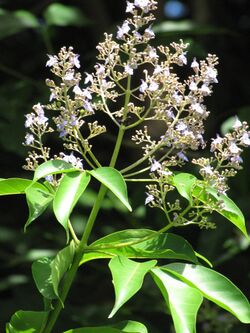Biology:Vitex parviflora
| Vitex parviflora | |
|---|---|

| |
| Scientific classification | |
| Kingdom: | Plantae |
| Clade: | Tracheophytes |
| Clade: | Angiosperms |
| Clade: | Eudicots |
| Clade: | Asterids |
| Order: | Lamiales |
| Family: | Lamiaceae |
| Genus: | Vitex |
| Species: | V. parviflora
|
| Binomial name | |
| Vitex parviflora Juss.
| |
Vitex parviflora[2] is a species of plant in the family Verbenaceae, also known as smallflower chastetree[3] or the molave tree. The name "molave" is from Spanish, derived from mulawin,[4] the Tagalog word for the tree.[5][6] It is also known as tugas in Visayan languages.[7][6] It yields one of two woods from the same genus called molave wood, the other being Vitex cofassus.
It is a native species in Indonesia, Malaysia, and the Philippines .[8] It can also be found in Central and South America, the Caribbean, Oceania, and Asia.[8] It was reported to be an invasive species in Guam and Hawaii after it became naturalized in O’ahu and escaped from cultivation in Guam.[8] In Cuba, it is also considered as a possibly invasive species due to naturalization.[8]
It is valued in the Philippines for its dense durable wood and was once used extensively in furniture, boats, utensils, and as construction material.[9] The wood is also known to resist decay and termites.[10] It became a protected species in the Philippines and it is illegal to cut its tree under certain conditions.[11] Before 2019, it was listed as critically endangered, threatened and vulnerable in the assessments recorded in the IUCN Red List.[12][13] As of 2017, the Philippine Department of Environment and Natural Resources classified it as endangered due to overharvesting and habitat loss.[14][15] Although in 2019, the species was reassessed and declared as least concern by IUCN.[1]
References
- ↑ 1.0 1.1 de Kok, R. (2020). "Vitex parviflora". IUCN Red List of Threatened Species 2020: e.T33339A67741355. doi:10.2305/IUCN.UK.2020-1.RLTS.T33339A67741355.en. https://www.iucnredlist.org/species/33339/67741355. Retrieved 15 November 2021.
- ↑ "Molave" (in en). https://onetotree.org/molave/.
- ↑ "Vitex parviflora". Natural Resources Conservation Service PLANTS Database. USDA. https://plants.usda.gov/core/profile?symbol=VIPA6.
- ↑ "Molave". Merriam-Webster Dictionary. https://www.merriam-webster.com/dictionary/molave. Retrieved 2022-09-23.
- ↑ (in en) Bulletin. Bureau of Public Printing. 1907. https://books.google.com/books?id=J4q-pR1gQIcC.
- ↑ 6.0 6.1 Merrill, Elmer Drew (1903). A dictionary of the plant names of the Philippine Islands. Manila: Bureau of Public Printing, Department of The Interior. p. 191. https://quod.lib.umich.edu/p/philamer/agj6434.0001.001/193.
- ↑ Bareja, Ben G.. "Two Strains of Molave Tree Distinguished". http://www.cropsreview.com/molave-tree.html.
- ↑ 8.0 8.1 8.2 8.3 "Vitex parviflora (molave)" (in en). https://www.cabi.org/isc/datasheet/56548#tosummaryOfInvasiveness.
- ↑ Lomosbog, Noel T.; Gamil, Noel S. (2015). "Characterization of Potential Molave (Vitex parviflora Juss.) Mother Trees in Lila, Bohol, Philippines". International Journal of Environmental and Rural Development 6 (2): 11–16. doi:10.32115/ijerd.6.2_11. https://www.jstage.jst.go.jp/article/ijerd/6/2/6_11/_article/-char/en.
- ↑ Alvina, Corazon S. (2020-04-12). "The Hardwoods of our Vanishing Forests" (in en-US). https://www.heraldsuites.com/the-hardwoods-of-our-vanishing-forests/.
- ↑ "PHILIPPINE ENVIRONMENT LAWS - CHAN ROBLES VIRTUAL LAW LIBRARY - FULL TEXT OF ACT NO. 3572". https://www.chanrobles.com/actno3572.htm#.Yy0PDkxByCh.
- ↑ "Threatened plants of the Philippines: a preliminary assessment". p. 28. http://www.nationalredlist.org/files/2013/07/Threatened-plants-Philippines-paper-updated-07Feb2008-ALS-format-2.pdf.
- ↑ Berame, Julie; Bulay, Minie L.; Mercado, Rissa M. (2021-06-05). "Sustaining angiosperms' diversity of Bood Promontory and Eco-Park, Butuan City, Philippines: Step towards a community based-protection management program" (in en). Biodiversitas Journal of Biological Diversity 22 (6). doi:10.13057/biodiv/d220662. ISSN 2085-4722. https://smujo.id/biodiv/article/view/8355.
- ↑ "Molave". Rain Forest Restoration Initiative. https://rainforestrestorationinitiative.wordpress.com/2016/01/22/molave/.
- ↑ Bareja, Ben G.. "The Molave Trees are Amazing, What With Their Plenty of Conventional Uses and New Ones That Evolved". http://www.cropsreview.com/molave-trees.html.
External links
- Wood Species and their Botanical Names in Alphabetical Order - (Molave is listed here.)
Wikidata ☰ Q1373994 entry
 |


